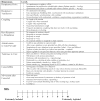State Behavioral Scale: a sedation assessment instrument for infants and young children supported on mechanical ventilation
- PMID: 16446601
- PMCID: PMC1626525
- DOI: 10.1097/01.PCC.0000200955.40962.38
State Behavioral Scale: a sedation assessment instrument for infants and young children supported on mechanical ventilation
Abstract
Objective: To develop and test the reliability and validity of the State Behavioral Scale for use in describing sedation/agitation levels in young intubated patients supported on mechanical ventilation.
Design: : In this prospective, psychometric evaluation, pairs of trained pediatric critical care nurse evaluators simultaneously and independently assessed a convenience sample of pediatric intensive care unit patients along eight state/behavioral dimensions and a numeric rating scale (NRS) of 0 (extremely sedated) to 10 (extremely agitated). The eight dimensions were derived from the sedation/agitation literature and expert opinion and included respiratory drive, response to ventilation, coughing, best response to stimulation, attentiveness to careprovider, tolerance to care, consolability, and movement after consoled, each with 3-5 levels.
Setting: An 18-bed pediatric medical-surgical intensive care unit and 26-bed pediatric cardiovascular intensive care unit in a university-affiliated academic children's hospital.
Patients: A total of 91 intubated mechanically ventilated patients 6 wks to 6 yrs of age provided a median of two observations (interquartile range, 1-3) for a total of 198 sets of observations. Excluded were postoperative patients or those receiving neuromuscular blockade.
Interventions: Patients were observed for 1 min, and then incremental levels of stimulation were applied until patient response. After 2 mins of consoling, the state behavioral assessment and NRS were completed.
Measurements: Weighted kappa and intraclass coefficients were generated to assess interrater reliability of the eight dimension and NRS ratings. Distinct state behavior profiles were empirically identified from the dimension ratings using hierarchical cluster analysis using a squared Euclidean distance measure and between-groups linkage. Construct validity of these profiles was assessed by comparing group mean NRS scores using one-way analysis of variance.
Main results: Weighted kappa scores for all 198 dimension ratings ranged from .44 to .76, indicating moderate to good interrater reliability. The intraclass coefficient of .79 was high for NRS ratings. Cluster analysis revealed five distinct state profiles, with mean NRS ratings of 1.1, 2.5, 4.0, 5.3, and 7.6, all of which differed significantly from each other (F = 75.8, p < .001), supporting the profiles' construct validity.
Conclusions: Based on empirically derived state behavior profiles, we have constructed the State Behavioral Scale to allow systematic description of the sedation-agitation continuum in young pediatric patients supported on mechanical ventilation. Further studies including prospective validation and describing the effect of State Behavioral Scale implementation on clinical outcomes, including the quality of sedation and length of mechanical ventilation, are warranted.
Conflict of interest statement
the authors have no financial interests to disclose.
Figures
Comment in
-
Validation of a sedation scale for young mechanically ventilated children: a painful challenge?Pediatr Crit Care Med. 2006 Mar;7(2):183-4. doi: 10.1097/01.PCC.0000209189.41110.DF. Pediatr Crit Care Med. 2006. PMID: 16531951 No abstract available.
References
-
- Gordin PC. Assessing and managing agitation in a critically ill infant. MCN Am J Matern Child Nurs. 1990;15(1):26–32. - PubMed
-
- Marx CM, Rosenberg DI, Ambuel B, Hamlett KW, Blumer JL. Pediatric intensive care sedation: survey of fellowship training programs. Pediatrics. 1993;91(2):369–378. - PubMed
-
- Durbin CG. Sedation in the critically ill patient. New Horiz. 1994;2(1):64–74. - PubMed
-
- Chevron V, Menard JF, Richard JC, Girault C, Leroy J, Bonmarchand G. Unplanned extubation: risk factors of development and predictive criteria for reintubation. Crit Care Med. 1998;26(6):1049–1053. - PubMed
-
- Kollef MH, Levy NT, Ahrens TS, Schaiff R, Prentice D, Sherman G. The use of continuous i.v sedation is associated with prolongation of mechanical ventilation. Chest. 1998;114(2):541–548. - PubMed
Publication types
MeSH terms
Substances
Grants and funding
LinkOut - more resources
Full Text Sources
Medical


